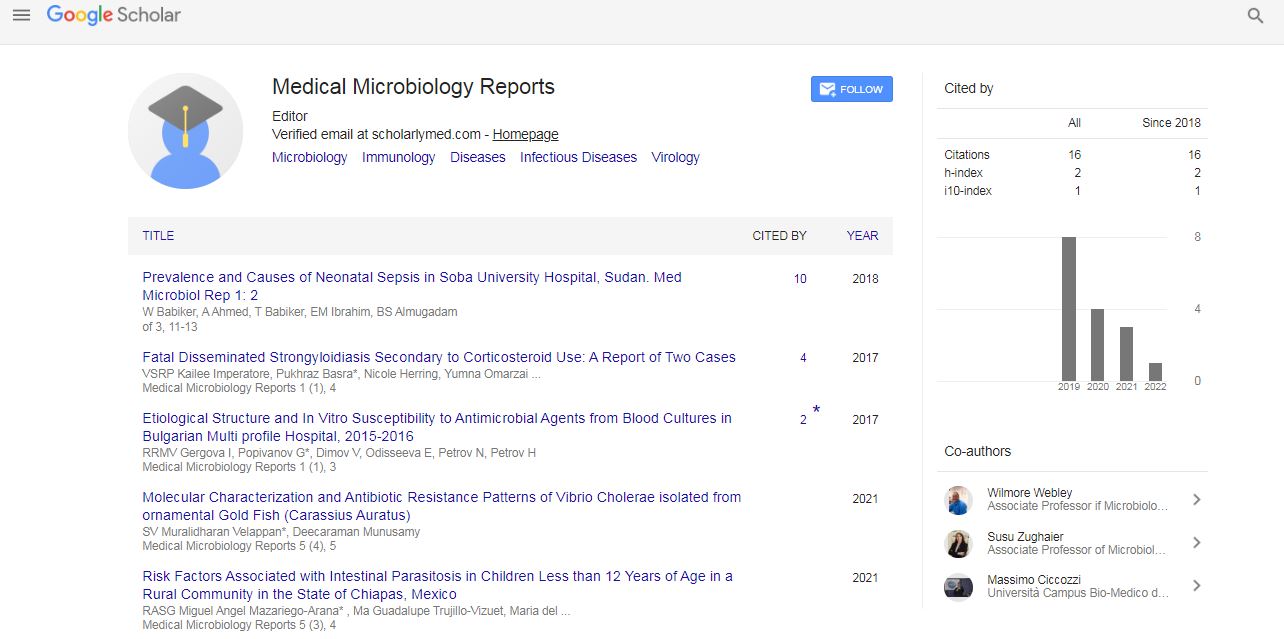Opinion Article, Med Microbiol Rep Vol: 7 Issue: 4
Assessing the Mycological Nuances of Fungal Fantasia
Jerad Fortey*
1Department of Plant Breeding, Wageningen University and Research, Wageningen, the Netherlands
*Corresponding Author: Jerad Fortey,
Department of Plant Breeding,
Wageningen University and Research, Wageningen, the Netherlands
E-mail: jerfort@wur.nl
Received date: 24 November, 2023, Manuscript No. MMR-24-128540;
Editor assigned date: 27 November, 2023, PreQC No. MMR-24-128540 (PQ);
Reviewed date: 11 December, 2023, QC No. MMR-24-128540;
Revised date: 18 December, 2023, Manuscript No. MMR-24-128540 (R);
Published date: 26 December, 2023, DOI: 10.4172/MMR.1000356
Citation: Fortey J (2023) Assessing the Mycological Nuances of Fungal Fantasia. Med Microbiol Rep 7:4.
Description
The natural world is so complicated that the fungi occupy a space of enchanting complexity. Mycology, the branch of biology dedicated to the study of fungi, reveals an enclosed world of organisms that play vital roles in ecosystems, agriculture and medicine. Exploring the nuances of mycology the fungal fantasia is an expedition that reveals the extraordinary diversity, ecological significance and scientific fascination encapsulated within the fungal kingdom. At the core of mycology is the exploration of fungal diversity, a vast and complicated environment that stretches from the microscopic to the macroscopic. Fungi, ranging from single-celled yeasts to elaborate mushroomforming species, exhibit a remarkable array of forms, colors and functions. The study of morphology, reproductive structures and genetic markers allows mycologists to discern the unique characteristics that distinguish one fungal species from another.
One of the key nuances within fungal fantasia lies in the mycelium, the complicated network of structures resembling connections that constitutes the vegetative body of fungi. These hyphae networks extend through soil, decaying matter and even within living organisms in mutualistic or parasitic relationships. The mycelium not only serves as the feeding apparatus of fungi but also acts as a communication network, allowing for chemical signaling and nutrient exchange. Understanding the complexities of mycelial networks demonstrates how fungi are interconnected with the environment, influencing nutrient cycling and ecological balance. Fungal fantasia extends to the reproduction strategies employed by fungi, which frequently display both non-sensual and sensual modes. Some fungi release countless microscopic spores into the air, while others rely on specialized structures like mushrooms or puffballs to disperse spores. The study of fungal reproduction not only contributes to the appreciation of the life cycles but also develop practical implications for agriculture, forestry and disease management.
Ecological partnerships form another layer of mycological nuances within fungal fantasia. Mycorrhizal associations, where fungi form symbiotic relationships with plant roots, exemplify the complex connections fungi establish with other organisms. Exploring these mycorrhizal nuances provides inputs into the meticulous equilibrium within ecosystems, highlighting the mutual dependencies that shape the dynamics of plant-fungal interactions. Fungal fantasia becomes more transparent with the study of pathogenic fungi that cause diseases in plants, animals and humans. The complex mechanisms, by which pathogenic fungi invade host tissues, evade immune responses and establish infections highlight the need for comprehensive mycological analysis in the fields of medicine and agriculture. Unraveling the molecular nuances of fungal pathogenesis not only informs the development of antifungal treatments but also aids in the breeding of resistant crop varieties.
Conclusion
Mycology explores the world of mycotoxins, secondary metabolites produced by certain fungi that can be harmful to humans and animals. Understanding the nuances of mycotoxin production involves investigating the environmental conditions and genetic factors that influence toxin synthesis. This knowledge is important for monitoring food safety, preventing contamination of crops and reducing the risk to health, associated with the consumption of mycotoxin-contaminated products. Beyond the ecological and medical fields, mycology intersects with industrial applications, providing a wealth of information of all the possibilities. Fungi contribute to the production of enzymes, organic acids and bioactive compounds with applications in biotechnology, bioenergy and pharmaceuticals. The exploration of these mycological nuances paves the way for sustainable solutions, such as using fungi in bioremediation to clean up environmental pollutants for the production of valuable compounds.
 Spanish
Spanish  Chinese
Chinese  Russian
Russian  German
German  French
French  Japanese
Japanese  Portuguese
Portuguese  Hindi
Hindi 
